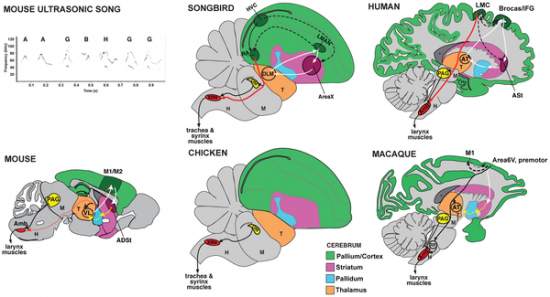Duke University
Source - http://phys.org/news/2013-02-roots-language-human-bird-biology.html#jCp
The genes activated for human speech are similar to the ones used by singing songbirds, new experiments suggest.

Brain systems for vocalization in birds and mammals./ doi:10.1371/journal.pone.0046610.g001
These results, which are not yet published, show that gene products produced for speech in the cortical and basal ganglia regions of the human brain correspond to similar molecules in the vocal communication areas of the brains of zebra finches and budgerigars. But these molecules aren't found in the brains of doves and quails—vocal birds that do not learn their sounds.
"The results suggest that similar behavior and neural connectivity for a convergent complex trait like speech and song are associated with many similar genetic changes," said Duke neurobiologist Erich Jarvis, a Howard Hughes Medical Institute investigator.
Jarvis studies the molecular pathways that songbirds use while learning to sing. In past experiments, he and his collaborators found that songbirds have a connection between the front part of their brain and nerves in the brainstem that control movement in muscles that make songs in birds. They've seen this circuit in a more primitive form related to ultrasonic mating calls in mice. Humans also have this motor learning pathway for speech.
From this and other work, Jarvis developed the motor theory for the origin of vocal learning, which describes how ancient brain systems used to control movement and motor learning evolved into brain systems for learning and producing song and spoken language.
More information: PLOS ONE. 7(10):e46610. doi: 10.1371/journal.pone.0046610